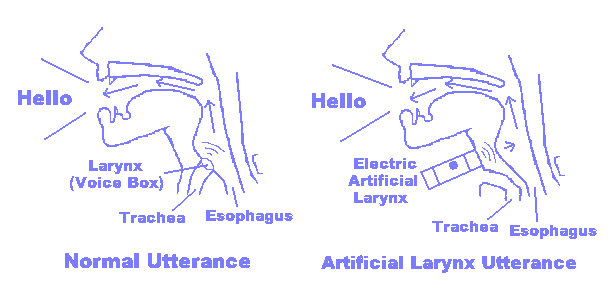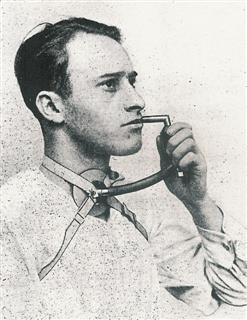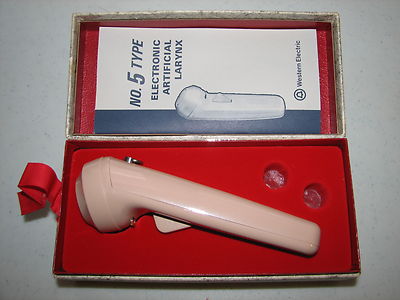Difference between revisions of "Electrolarynx"
(Important Dates) |
(Public & Media Impact and Presentation) |
||
| Line 45: | Line 45: | ||
== Public & Media Impact and Presentation == | == Public & Media Impact and Presentation == | ||
| + | |||
| + | The users of electrolarynges feature in the newspapers just rarely. Judy Siegel-Itzkovich reports in her article about voice problems that there is one Holocaust's victim in Israel who has to use electrolarynx. His larynx was damaged during medical experiments in a concentration camp by Josef Mengele.<ref>SIEGEL-ITZKOVICH, Judy. Voice of the people. The Jerusalem Post [online]. 2015, Apr 26. Available online at: http://www.jpost.com/Israel-News/Health/Voice-of-the-people-399185 (Retrieved 17th January, 2017). | ||
| + | </ref> | ||
| + | |||
| + | Jake Polden from ''Daily Mail'' reports Brazilian social experiment, where cigarettes were sold by Joao Candido, the man who lose his voice due to consumption of them. He points out that customers were considerably affected by Candido's story.<blockquote>Joao then drops the biggest bombshell yet and reveals to a curious man what the device is he is holding, allowing him to speak. He tells the man that it is an electronic larynx - something he has had to use since his vocal cords were removed due to larynx cancer. Joao says: 'I had already stopped smoking for 14 years when I had the cancer. But either way it was because of the cigarettes.' The revelation is met with many shocked looks from the customers attempting to buy cigarettes from the man. Later a customer states that the experience scared him slightly, while a woman says that this is the time to stop.<ref>POLDEN, Jake. When smoking does not kill: Smokers receive powerful wake-up call when buying cigarettes from a man with an electrolarynx. Daily Mail [online]. 2015, Sep 2. Available online at: http://www.dailymail.co.uk/news/article-3219431/When-smoking-does-not-kill-Smokers-receive-powerful-wake-call-buying-cigarettes-man-electrolarynx.html#ixzz4W0g49sAC (Retrieved 17th January, 2017). | ||
| + | </ref></blockquote> | ||
| + | |||
== Public Policy == | == Public Policy == | ||
Revision as of 10:39, 17 January 2017
List of Electrolarynges:
Electrolarynges are speech technologies and medical devices. They were developed for laryngectomy patients, who lost their capacity to speak. 'Larynx' in the title of the device means, that it is supposed to replace patient's lost or damaged larynx.
Electrolarynges are electronic devices, mainly powered by battery. They produced a vibration which could user modulate to words by his jaws, tongue and lips.
Contents
Main Characteristics
Electrolarynges are battery-powered devices that replace the sound-vibrating capabilities of the larynx. There are two types of electrolarynges the first neck-type usually resembles a small hand-held tube that the user operates with one hand, while the second intra-oral consists of two parts a pulse generator with a battery and the tone generator.[1] The former type of devices is put against the tissue of the throat or under the chin.[2] The latter contains a plastic tube which is inserted into patient's mouth.[3] The neck-type of electrolarynx is more widely used than the intra oral type of electrolarynx.[4]
The sound of patient's voice is produced by the vibration a a device. The vibrations the device generates are then carried over to the inside of the oral cavity. The user can then use the rest of the vocal tract to shape the sound and speak.[4] This allows people who have lost either a part or the entire larynx due to cancer to be able to produce speech and to communicate again.
Electrolarynx is just one of the options for laryngectomees. After the lost of their voice they could also develop pharyngeal, buccal or esophageal voice production. However, not every laryngectomee is able to develop any of this voice. The voice can be also restored by surgery and the use of silicone prostheses, which is widely discussed in Speech prostheses.[5] Patients could also used speech speech synthesizers.
Historical overview
The current electrolarynges are hand-held electromechanical devices that use a small vibrator to vibrate the inside of the oral cavity. However, pneumatic external larynges were used before miniaturization allowed such devices to be battery-powered and of portable size. The first laryngeal prostheses was described by Czech physiologist Jan Nepomuk Czermak in 1859. This device was not electrical, however, but it was powered by the air. The voice was conducted through vibrating tube in patient's mouth. Based on the ideas of Czermak, Brucke actually invented a speech prostheses, which allowed patients to pronounced single syllables. There were developed a great deal of various artificial larynges in the end of 19th century and the beginning of 20th century. Although majority of the devices was powered by air, certain developers also tested electrical devices.
In the beginning of 20th century, artificial larynges were still unreliable and the quality of sound was not sufficient. These features discouraged many possible patients from purchasing any of these devices. The disadvantages were overcame in 1924 by J. E. Mackenty, who found out than the soft rubber mouth piece could improve the quality of patient's speech. In order to allow shipping of his invention, he cooperate with the Western Electric Company.[1] Therefore, the first available pneumatic artificial larynx was introduced by the Western Electric Company as the Western Electric No° 2 type larynx.[6] It was available on the market from 1930 to 1959.[7] These devices were attached to the tracheostoma of the patient. The device was shaped in such a way that the exhaled air produced a humming noise. It was then carried via a small tube to the inside of the patient's mouth where it served as a base for speech much like the vibrations produced by a modern electrolarynx.[8]
The first battery-powered electrolarynx was introduced by Wright in 1942. He later joined Aurex Corporation and later Kett Engineering Corporation, which developed first electrolarynges Aurex Model M 410 resp. Kett Mark I. These devices contained a vibrator connected by the battery with a cord. The later model of both companies Aurex Model M 520 and Kett Mark II, however, had battery included in a devices.[1] The example of the former type of device could be Cooper-Rand electrolarynx, while the latter type represents Nu-Vois, Romet R, Servox, SolaTone, and TruTone.
Purpose
Electrolarynges is directed towards laryngectomy patients that lost their ability to produce speech. The usage of an electrolarynx, is one of the options which allows them to communicate.
Important Dates
- 1859 - Jan Nepomuk Czermak suggested the first pneumatic laryngeal prosthesis
- 1873 - Billroth conducted the first successful total extirpation of the larynx
- 1924 - Mackenty in cooperation with Western Electric Company developed the first available pneumatic larynx[1]
- 1942 - Wright's first electrolarynx 'Sonovox' was introduced[4]
Enhancement/Therapy/Treatment
Ethical & Health Issues
Public & Media Impact and Presentation
The users of electrolarynges feature in the newspapers just rarely. Judy Siegel-Itzkovich reports in her article about voice problems that there is one Holocaust's victim in Israel who has to use electrolarynx. His larynx was damaged during medical experiments in a concentration camp by Josef Mengele.[9]
Jake Polden from Daily Mail reports Brazilian social experiment, where cigarettes were sold by Joao Candido, the man who lose his voice due to consumption of them. He points out that customers were considerably affected by Candido's story.
Joao then drops the biggest bombshell yet and reveals to a curious man what the device is he is holding, allowing him to speak. He tells the man that it is an electronic larynx - something he has had to use since his vocal cords were removed due to larynx cancer. Joao says: 'I had already stopped smoking for 14 years when I had the cancer. But either way it was because of the cigarettes.' The revelation is met with many shocked looks from the customers attempting to buy cigarettes from the man. Later a customer states that the experience scared him slightly, while a woman says that this is the time to stop.[10]
Public Policy
Related Technologies, Projects or Scientific Research
http://drtbalu.com/Voice_rehab.html
http://www.drshute.com/archives/2004/08/current_trends.html
UEMI, Norihiro, et al. Design of a new electrolarynx having a pitch control function. In: Robot and Human Communication, 1994. RO-MAN'94 Nagoya, Proceedings., 3rd IEEE International Workshop on. IEEE, 1994. p. 198-203.
LIU, Hanjun, et al. Enhancement of electrolarynx speech based on auditory masking. Biomedical Engineering, IEEE Transactions on, 2006, 53.5: 865-874.
References
- ↑ 1.0 1.1 1.2 1.3 KEITH, Robert L., SHANKS, James, Laryngectomee Rehabilitation: Past and Present. In: Speech and Language: Advances in Basic research and Practice. New York: Academic Press, 1983. Available online at: https://books.google.cz/books?id=0C60BQAAQBAJ&pg=PA126&lpg=PA126&dq=Cooper-Rand+electrolarynx&source=bl&ots=or27eudDf2&sig=22heagC08Fpk57qGILvufHxwCyM&hl=cs&sa=X&ved=0ahUKEwi1--bt3r7RAhWGuxQKHbrFCC04ChDoAQgdMAE#v=onepage&q=Cooper-Rand%20electrolarynx&f=false (Retrieved 13th January, 2017).
- ↑ SHUTE, Brian. There's Nothing Like the Sweet Spot: Placement of the Artificial Larynx. DrShute.com [online]. 1997, Oct. Available online at: http://www.drshute.com/archives/2004/08/theres_nothing.html (Retrieved 16th January, 2017).
- ↑ Advance Health Network. Industry News: Cooper-Rand Electronic Speech Prosthesis. Advance Health Network [online]. Available online at: http://speech-language-pathology-audiology.advanceweb.com/Article/Cooper-Rand-Electronic-Speech-Prosthesis.aspx (Retrieved 13th January, 2017).
- ↑ 4.0 4.1 4.2 LIU, Hanjun; NG, Manwa L. Electrolarynx in voice rehabilitation. Auris Nasus Larynx, 2007, 34.3: 327-332.
- ↑ BROWN, Dale H. et al. Postlaryngectomy Voice Rehabilitation: State of the Art at the Millennium, World Journal of Surgery [online]. 2003, 14 May. DOI: 10.1007/s00268-003-7107-4 Available online at: http://link.springer.com/article/10.1007/s00268-003-7107-4 (Retrieved 16th January, 2017).
- ↑ RIESZ, R. Description and demonstration of an artificial larynx. Journal of the Acoustical Society of America 1929; 1: 273-9.
- ↑ VAN DER TORN, Marein. A sound-producing voice prosthesis. Ph. D. Thesis. Amsterdam. VU Medical Center: VU Medical Center, 2005.
- ↑ National Cancer Institute. Pneumatic larynx. NCI Dictionary of Cancer Terms [online]. Available online at: http://www.cancer.gov/publications/dictionaries/cancer-terms?CdrID=46223 (Retrieved 16th January, 2016).
- ↑ SIEGEL-ITZKOVICH, Judy. Voice of the people. The Jerusalem Post [online]. 2015, Apr 26. Available online at: http://www.jpost.com/Israel-News/Health/Voice-of-the-people-399185 (Retrieved 17th January, 2017).
- ↑ POLDEN, Jake. When smoking does not kill: Smokers receive powerful wake-up call when buying cigarettes from a man with an electrolarynx. Daily Mail [online]. 2015, Sep 2. Available online at: http://www.dailymail.co.uk/news/article-3219431/When-smoking-does-not-kill-Smokers-receive-powerful-wake-call-buying-cigarettes-man-electrolarynx.html#ixzz4W0g49sAC (Retrieved 17th January, 2017).



